- BACKGROUND
- 1) The circumstances which led to the adoption or amendment of a flag.
2) In vexillology see field 1) and the note below.
3) In heraldry see field 2).
![[background]](../images/v/vx-hr-sb-ng.gif)
![[background]](../images/v/vx-hr)sb-ng.gif)
Flag and Arms of Nova Gradiška, Croatia
Please note with regard to 2) that the word is occasionally used to indicate a colour within, or of, a charge.
- BACKING
- The material or surface upon which an old flag is placed for the purposes
of stabilization or preservation.
- BADGE
- 1) Generically, any emblem sometimes derived from the symbols contained in
a full set of armorial bearings, but which does not contain a shield (see also
anti-heraldry,
armorial bearings,
emblem,
charge and
shield).
- 2) Specifically see badge in heraldry and the note below.
- 3) In UK usage, that emblem formerly placed in the fly half of a defaced
Blue (or Red)
Ensign in order to distinguish between British colonies, and used in place of
a full set of armorial bearings, or the shield from those arms (see also
blue ensign,
colonial flags,
deface, disc
and government ensign’ under
ensign).
- 4) The insignia of a military or naval unit often incorporated into the design
of its cap badge, arm flash/patch, colour or other organizational flag – but see
emblem, military and governmental/departmental
(also camp flag,
colour 2),
grommet 2),
rope grommet,
military crest and
ship’s crest).
![[badge illustration]](../images/v/vxt-d2249.gif)
![[badge illustration]](../images/v/vx-su)by.gif)
![[badge illustration]](../images/v/vx-lk_gens75.gif)
Camp Flag of the Training and Development Branch, Canada;
Badge/Emblem of the Belarussian SSR;
Flag of British Ceylon 1825–1948
Please note with regard to 1) however, that with a large degree of
heraldic justification, some sources propose the charge to be an integral part
of a flag’s design and generally not used separately, whereas, in general a badge
may. It is, therefore, suggested that the entry ‘badge in heraldry’ below and
a suitable glossary or heraldic dictionary be consulted.
- Badge in Heraldry
- A mark of distinction somewhat similar to a crest, though not placed on a
wreath, nor worn upon the helmet. Badges are rather supplemental bearings quite
independent of the charge of the original arms; they are borne on various flags,
and formerly upon the breasts – or more frequently the sleeves – of servants and
followers (see also badge banner,
badge pennon,
pinsel and
heraldic standard.
![[badge illustration]](../images/v/vx-plantag.gif)
![[badge illustration]](../images/v/vx-tudorrose.gif)
![[badge illustration]](../images/v/vx-prinwales.gif)
Badge of the Royal House of Plantagenet 1154–1399, England; Badge of the Royal House
of Tudor 1486–1603, England; Badge of HRH Prince William of Wales, UK (all: aroyalheraldry.weebly.com).
Notes
a) In Scottish heraldry, the crest on the wreath may be used as a badge.
b) It is suggested that the badge fell out of general
use in personal English heraldry during the reign of Queen Elizabeth I (1533–1603).
- BADGE BANNER
- The term for a small square flag showing a person’s badge, probably against
livery colours, and particularly (but not exclusively) for use at that person’s funeral
– a practice now largely (if not entirely) obsolete
(see also badge in heraldry
bannerole,
great banner,
grumphion,
livery banner and
livery colours).
![[badge banner]](../images/v/vxt-d667.gif)
Badge Banner of the Royal House of Tudor, England c1530
- BADGE PENNON
- The term for a medieval lance pennon (usually carried by those mounted men-at-arms who
were non-armigerous) that displayed a heraldic badge against livery colours – but see
pennoncel
(also armigerous,
banneret 2),
Badge in Heraldry,
lance,
livery colours 1),
pennon 3)) and
pennoncier.
![[badge banner]](../images/v/vxt-d668.gif)
Badge Pennon of the Earls of Warwick, England c1450
- BALCANIFER (or BALDAKINIFER)
- Alternative medieval terms for the standard bearer of the Knights Templar (see also
bauceant and
enceniator).
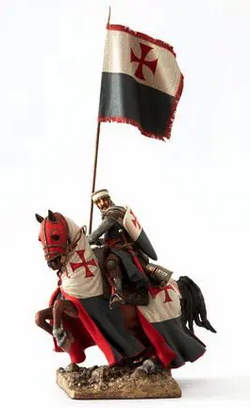
(templerinfo.de)
- BALK CROSS
- An accurate but seldom used translation (Balken meaning a "balk", "bar"
or "beam" of wood) of the German term Balkenkreuz – see balkenkreuz.
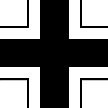
- BALKAN CROSS
- An often used, but incorrect, translation (Balken meaning a "balk", "bar"
or "beam" of wood)
of the German term Balkenkreuz – see balkenkreuz.

Please note that this cross (in essence a simplified form of the Iron Cross) was
originally introduced as a German aircraft marking in April 1918, and has no connection
with the Balkans.
- BALKENKREUZ
- The German term that is used to describe a black Greek cross fimbriated white, and employed
from 1935–1945 by German forces as a mark of national identity on their military vehicles
and aircraft – a Balken, balk, bar or beam cross – but see the note below (also
fimbriation,
fuselage marking,
Greek cross and
iron cross) .
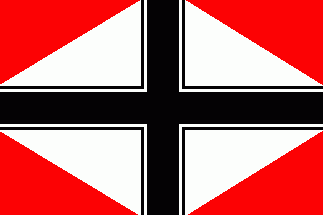

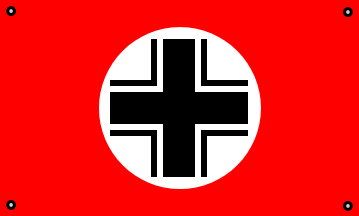
Flag of the German Sailing Union 1912–1934;
Example;
Aircraft Recognition Drape of the Army ca. 1944, Germany
Please note that this cross (a simplified form of the Iron Cross as referenced above and illustrated
below) was originally introduced as a German aircraft marking in April 1918, and has no connection
with the Balkans.
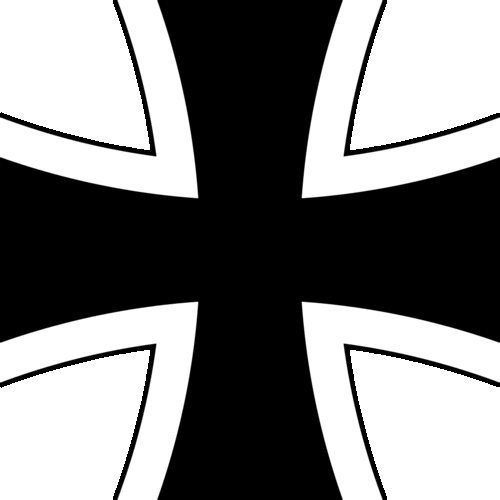
Aircraft Recognition mark c1917 and in current use, Germany (Wikipedia)
- BALL(S)
- 1) In vexillology see disc
(also balls of difference).
2) In heraldry see roundel 3).
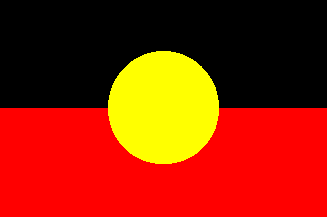
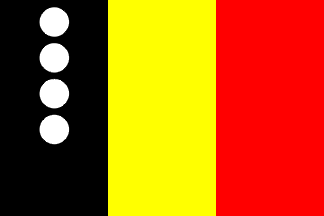
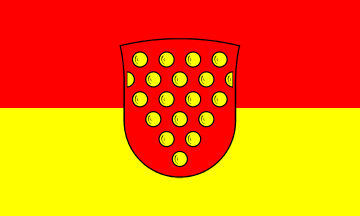
Aboriginal Flag, Australia;
Lt Admiral's Rank Flag c1858, Belgium;
Flag of Grafschaft Bentheim, Germany
- BALL(S) OF DIFFERENCE
- In British Royal Navy usage and some others, the disc or discs of distinction carried by the command
flags of those flag officers who rank below the grade of full admiral – see
boat flag 3) (also
disc,
flag of command 1),
flag officer 1), flag officer 2) and
marks of difference 1).
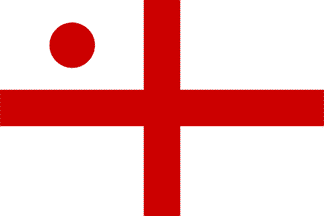
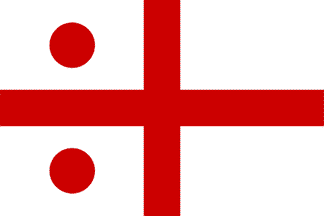
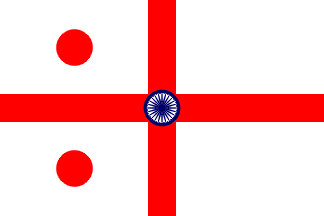
Flags of a Vice Admiral and Rear Admiral
Royal Navy, United Kingdom; Flag of a
Rear Admiral 1950–2001, India.
Please note that in British usage the present design dates from regulations of 1898.
These regulations reduced the width of the red cross, increased the size of the balls and
moved their position on the flag of a rear-admiral (as illustrated below).
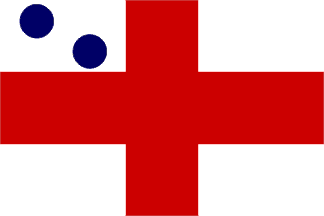
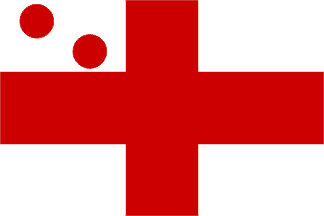
Boat Flag of a Rear Admiral of the White ca. 1702–1864;
Boat Flag and then Command Flag of a Rear-Admiral 1864–1898, UK
- BALZAUS
- See bauceant.
![[Bauceant]](../images/v/vx-rel-baux.gif)
A conjectural image of the Balzaus/Bauceant
- BAND(S)
- See stripe(s).
![[example of stripes]](../images/v/vx-cf.gif)
National Flag of the Central African Republic
- BANDERA DE CEREMONIA
- See indoor flag.
![[bandera de ceremonia]](../images/v/vx-ar.gif)
National Flag of Argentina
- BANDERA DE GUERRA
- See war flag.
![[bandera de guerra]](../images/v/vx-pe^.gif)
![[bandera de guerra]](../images/v/vx-pe)emb.gif)
Bandera de Guerra/War Flag, and
National Arms of Peru
- BANDERAS CORONELAS
- See crown colours.
![[bandera de guerra]](../images/v/vx-es^1810b.gif)
Banderas Coronelas/King’s Colour of the Barcelona Regiment of
Light Infantry 1810, Spain
- BANDERARIUS (BANDARENSIS, BANDONARIUS or BANDEZATUS)
- Alternative medieval terms, now obsolete, for a standard bearer.
![[banderarius]](../images/v/vx-banderarius.jpg)
(figurenschnapp.de)
- BANDERIUM
- A medieval term, now obsolete, for a military unit serving under the banner
of a feudal lord (see also banner 1),
banneret 2), and
vexillation).
- BANDEROLE (BANDEROL, BANDEROLLE, BANDROL, BANDROLE or BANDERVILLE)
- 1) Alternative medieval terms, now obsolete, for a small banner (see also
banner of arms)).
- 2) A streamer or ribbon – often with an inscription – normally used alone
(as on a crosier) rather than as an accessory to a flag – an orarium (see also
scarf,
pencel and
streamer).
- 3) Alternative heraldic terms for the streamer attached to a helmet or crest (see also
crest,
pencel
and helm).
- 4) A small flag flown as an accessory to a larger one.
Please note – not to be confused with bannerole.
![[banderole]](../images/v/vx-ch-be105.gif)
Flag of Sonvilier, Switzerland
- BANDUM (or BANDERIA)
- 1) A medieval term, now obsolete, for a small banner (see also
banneret and
bannerette).
- 2) The Latin form of the Greek bandon which was a Byzantine military flag.
Please note, that banderia is a plural form of bandum,
and that it has been suggested 1) may have been Latinized from a Celtic original.
- BANERA (BANERIA, BANERIUM or BANNERIUM)
- Medieval terms, now obsolete, for a banner.
![[banera]](../images/v/vxt-d1088.gif)
![[banera]](../images/v/vx-hu_anjou.gif)
Banera/Lance Pennon, English c1360; Banera/Banner from Hungary 14th c.
- BANNER OF ARMS
- The heraldic term for that flag which is a square or rectangular version of the shield from a set of
armorial bearings – an armorial banner or heraldic banner – but see
armorial banner 2) (also
armorial bearings,
armorial flag,
blazon,
coat of arms 2),
heraldic standard,
lance pennon 1),
marshalling,
quarterly,
shield 2) and heraldic standard).
![[banner of arms]](../images/v/vx-cz-sy-gr.gif)
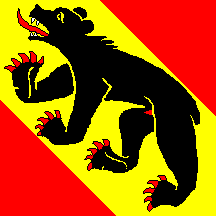
![[banner of arms]](../images/v/vx-cz-br-hb.gif)
Flag of Gruna, Czechia;
Flag of Bern, Switzerland;
of Horní Benešov, Czechia
- BANNER OF COUNCIL
- In English, then British and some other naval usages, now obsolete, a flag (often the Royal Standard) that
was used prior to the invention of a signal code to summon a council of war aboard
the flagship – but see notes below (also flagship
and signal flag;).
![[badge illustration]](../images/v/vx-gb-1399.gif)
![[badge illustration]](../images/v/vx-gb-royun.gif)
English Royal Standards 1340–1603; plus
1603–1688 and 1701–1714
Notes
a) A banner of council first appeared in English sources during the first
half of the 14th century (dates of between 1337 and 1351 are suggested), and had ceased to be recorded
by the 18th century.
b) Use of a flag with
this meaning was by no means limited to England’s navy, with instructions for
a combined Mediterranean galley fleet of 1366 being just one example.
- BANNER OF THE REALM
- A translation of the Dutch “rijksvaandel” and proposed translation of the Norwegian term “riksbanner”
– a royal banner –
but see coronation flags.
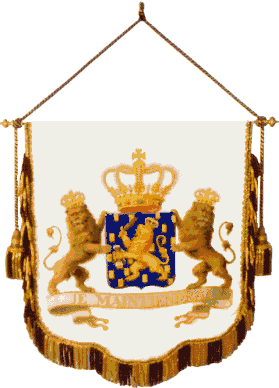
Rijksvaandel of the Netherlands
- BANNER OF VICTORY
- 1) Specifically, the flag which (traditionally) was first raised by victorious
Soviet forces over the Reichstag, Berlin on 20 April 1945, and which is preserved in the Central
Museum of the Armed Forces, Moscow with a reproduction being displayed in the
annual Victory Day Celebration – but see note below (also also
red flag 3)).
- 2) Generically, the flag of any combatant who is victorious in a battle or in a war (see also
banner 8)).
![[Russian banner of victory]](../images/v/vx-su^vctry.gif)
![[Russian banner of victory]](../images/v/vxt-d501a.gif)
Banner Raised Over The Reichstag, Berlin 1945; Banner According To
Current Practice (CS)
Notes
a) With regard to 1), the Cyrillic wording on the flag –
150 стр. Ордена Кутузова II ст.
идрицк. див. 79 С.К. 3У.А.IБ.Ф
– means “150th Rifle Idrickaâ
Division (Awarded Order of Kutusov, II Degree), 79th Joint Corps, 3rd Shock
Army, 1st Byelorussian Front”
b) From 2005 any such flags officially
displayed at the Victory Day Celebrations will not show the hammer and sickle.
![[background]](../images/v/vx-hr-sb-ng.gif)
![[background]](../images/v/vx-hr)sb-ng.gif)
![[badge illustration]](../images/v/vxt-d2249.gif)
![[badge illustration]](../images/v/vx-su)by.gif)
![[badge illustration]](../images/v/vx-lk_gens75.gif)
![[badge illustration]](../images/v/vx-plantag.gif)
![[badge illustration]](../images/v/vx-tudorrose.gif)
![[badge illustration]](../images/v/vx-prinwales.gif)












![[example of stripes]](../images/v/vx-cf.gif)
![[bandera de ceremonia]](../images/v/vx-ar.gif)
![[bandera de guerra]](../images/v/vx-pe^.gif)
![[bandera de guerra]](../images/v/vx-pe)emb.gif)
![[bandera de guerra]](../images/v/vx-es^1810b.gif)
![[banderole]](../images/v/vx-ch-be105.gif)
![[banera]](../images/v/vxt-d1088.gif)
![[banera]](../images/v/vx-hu_anjou.gif)
![[banner of arms]](../images/v/vx-cz-sy-gr.gif)

![[banner of arms]](../images/v/vx-cz-br-hb.gif)
![[badge illustration]](../images/v/vx-gb-1399.gif)
![[badge illustration]](../images/v/vx-gb-royun.gif)

![[Russian banner of victory]](../images/v/vx-su^vctry.gif)
![[Russian banner of victory]](../images/v/vxt-d501a.gif)

![[badge banner]](../images/v/vxt-d667.gif)
![[badge banner]](../images/v/vxt-d668.gif)

![[Bauceant]](../images/v/vx-rel-baux.gif)
![[banderarius]](../images/v/vx-banderarius.jpg)